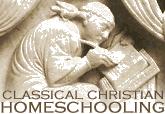Text Only
(Printer-Friendly)
coming soon
Contents
Introduction
Trivium
Grammar
Dialectic
Rhetoric
Homeschool
Curriculum
CCH FAQ
CE Links
Favorite
Reciprocal
What’s New
About CCH
Search CCH
Art History

Classical Christian
Homeschooling:
Classical Education
at Home
WebMaster:
Christine
Miller
CCH’s Online Catalog: 3rd Grade History: The Medieval World
This page last revised:
October 2002
Copyright © 1997-2002
|
The Dark Ages
The time of chaos and uncertainty when Europe was finding herself after the Fall of Rome
is known as the Dark Ages. Into the void left by the Roman Empire, Christianity brightly
took the lead.
The Middle Ages
The Middle Ages were a time when Christian society reigned supreme, and yet clouds were on
the horizon: while at times true Christian love shown through, also at times everything
evil was practiced in the name of Jesus Christ.
The Medieval World for Older
Students
If you are beginning classical education or homeschooling with older grammar stage
students, or need resources to fill in the facts of history with dialectic and rhetoric
stage students, these will do that at a higher reading level.
Medieval World Teacher’s
Resources
The medieval world built upon the foundation of Western Civilization begun by Greece and
Rome, but Christianity informed its direction and philosophies to the extent that the
world as we know it today would not exist without its supremacy. These essential resources
will help the homeschool parent grasp the big picture.
Many historians do not use the term “Dark Ages” anymore,
prefering to describe the entire period between the fall of Rome and the Renaissance as
the Middle Ages. However, since that era covers over 1000 years of history, I have broken
up that 1000 years into the traditional “Dark” and “Middle Ages.” As I
have used it, “Dark Ages” refers to that time of chaos and transition following
the fall of the Roman Empire when Europe was still finding herself; and when what we think
of as Medieval society was still developing. It lasted for several centuries after the
fall of Rome in 476 A.D.; the conquest of England by the Normans in 1066 is the
traditional transition date. The major players in the Dark Ages are the monks, the Franks,
the inhabitants of Britain (Britons (modern Welsh) originally, displaced by Saxons and
Angles (English) early in this period) and Ireland, the Islamic and Byzantine
civilizations, and the Vikings (Danes).
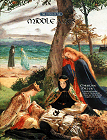 The
Story of the Middle Ages The
Story of the Middle Ages
Christine Miller, H. A. Guerber, Charlotte M. Yonge
Far and above all other narrative histories of the Middle Ages for
children, The Story of the Middle Ages is an excellent introduction to Western
Civilization after the Fall of the Roman Empire. Rich in detail, effortlessly weaving the
Biblical worldview throughout, this new history covers the complete scope of the medieval
era from the early inhabitants of Europe through the Hundred Years’ War and the War
of the Roses in 147 lessons. We learn of the barbarians, kings and saints that figured
prominently in Christendom: Sts. Denis, Martin, Patrick, Benedict, Louis, Francis and
more; Theodoric, Justinian, Gregory, Charles, and Otto the Great; Roland, El Cid, and
Richard the Lion-Hearted; the Crusades, and much, much more. This captivating history is a
completely new narrative taken in part from the 1895 and 1910 editions of H. A.
Guerber’s The Story of the English and The Story of Old France. It is
illustrated, and includes helpful maps and a comprehensive timeline. Chapters 1 through
66, Europe Long Ago through The Legend of El Cid, covers the period of the Dark Ages in
detail.
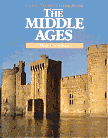 Cultural Atlas
for Young People: The Middle Ages Cultural Atlas
for Young People: The Middle Ages
Mike Corbishley
Beginning with a timeline that stretches from 300 A.D. through the 15th
century, this book, like the others in the Cultural Atlas for Young People series, is
lavishly illustrated with National Geographic- quality photos and full-page maps. Part One
covers a brief history of Medieval Europe, including the Barbarian movements, the empire
of Justinian, Ravenna, Carolingian Europe, Sutton Hoo (Saxon), Viking expansion, the
Byzantine empire; (Dark Ages), and the Plantagenet empire, the Bayeaux Tapestry, the
Doomsday Book, the Crusades, the German empire, the Medieval church, education, cathedral
building, stained glass, medieval arts and crafts, and science, medicine, and printing
(Middle Ages.) Part Two covers the lands of Medieval Europe, including France, Paris,
Italy, British Isles, Spain and Portugal, Switzerland, Germany, and the Low Countries,
Bohemia, Hungary, Greece, and the Balkans, Lithuania, Poland, and Russia, Russian village
life, and Scandinavia. It also includes short spreads on such topics as travel, trade,
castles, mapmaking, and everyday life.
 And God Blessed
the Irish: The Story of Patrick And God Blessed
the Irish: The Story of Patrick
Chris Driscoll
“A children’s book with much wider appeal. Accented with
charming, simple, cartoon-style illustrations, the book tells the story of St. Patrick,
including legends and folklore about the saint along with his actual history. Although
definitely geared towards children, And God Blessed the Irish can teach even
adults. And God Blessed the Irish tells the true history of St. Patrick, detailing
his incredible life in a creatively written and exciting story. It is a captivating tale
of adventure that entertains while it educates the reader.” Patrick was captured by
Irish slavers ca. 432 AD.
 Beowulf the
Warrior Beowulf the
Warrior
Ian Serraillier
Master storyteller and poet Ian Serraillier has rewoven in modern
narrative verse the story of Beowulf, the oldest epic in the English language. He succeeds
in making this classic tale accessible to today’s youth. His rendition is an
excellent introduction to both the events of the tale and the flow of the epic language
for young readers. Beowulf was a real historical person, as ancient records confirm; and
the poem is a pre-Christian era epic of the Saxons. The references to Old Testament
persons and events are not the work of later Christian revisionists, but handed down
generation after generation from the post-flood founders of the Saxon tribes. (See After the Flood for a thoroughly researched
account of the historicity of Beowulf.) The Saxons had established their Heptarchy in
Britain by 454 AD, and the writing of Beowulf can be internally dated to the pre-Christian
era of the Saxons between this time and their wars with Charlemagne (ca. 800 AD, see After
the Flood).
Dark Ages
Literature:
Bulfinch’s Mythology,
(especially The Legends of Charlemagne, ca. 800 AD), from 3rd
Grade Literature selections
 Nordic Gods and
Heroes Nordic Gods and
Heroes
Padraic Colum
Colum’s refreshing, straightforward rendition of the Norse legends,
classically illustrated with Willy Pogany’s clean, powerful drawings, is back in
print. All of the major legends are included, without unwelcome analyzation, including the
Ring saga (C.S. Lewis’ favorite tales when young, and inspiration for Tolkien’s
Lord of the Rings). Some of the Nordic myths are also included in Bulfinch's Mythology.
The Nordic myths comprised the ancient literature of the Northmen, the Vikings, who from
793-911 terrorized Europe.
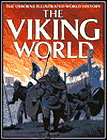 The Viking World The Viking World
Philippa Wingate, Anne Millard, and Jane Chisolm
Part of the acclaimed Usborne Time Travellers series. “This book
looks at the way the Vikings lived and captures their irrepressible spirit of adventure.
It follows the voyages of such Viking explorers as Leif Ericsson, who set foot in North
America 500 years before Christopher Columbus. Packed with pictures, maps and charts, The
Viking World is both a fascinating historical chronicle and a valuable work of
reference.” -The Publisher. Irrepressible spirit of adventure? Irrepressible spirit
of pillage and destruction would be closer to the truth.
The Story of the Middle Ages
Chapters 67 through 147, The Battle of Hastings through Richard’s Punishment, covers
the high medieval era in detail.
Cultural Atlas for Young People: The
Middle Ages
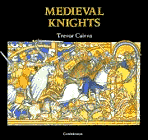 Medieval Knights Medieval Knights
Trevor Cairns
Trace the evolution of the soldier from Roman times to the knight of the
high medieval era. All the books in the Cambridge Introduction to World History series are
excellent for grammar stage students. Specializing in the history of Western Civilization,
they give both the big picture and depth and detail in ways that other modern
children’s books lamentably miss. Other excellent books in the Cambridge Introduction
to World History series on the medieval world include: The Growth of a
Medieval Town and Life in a
Medieval Monastery.
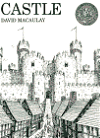 Castle Castle
David Macaulay
“Imagine yourself in 13th-century England. King Edward I has just
named the fictitious Kevin le Strange to be the Lord of Aberwyvern--‘a rich but
rebellious area of Northwest Wales.’ Lord Kevin’s first task is to oversee the
construction of a strategically placed castle and town in order to assure that England can
‘dominate the Welsh once and for all.’ And a story is born! In the Caldecott
Honor Book Castle, David Macaulay--author, illustrator, former architect and teacher--sets
his sights on the creation and destiny of Lord Kevin’s magnificent castle perched on
a bluff overlooking the sea. Brick by brick, tool by tool, worker by worker, we witness
the methodical construction of a castle through exquisitely detailed pen-and-ink
illustrations. Children who love to know how things work especially appreciate
Macaulay’s passion for process and engineering. Moats, arrow loops, plumbing,
dungeons, and weaponry are all explained in satisfying detail.” Another excellent
Macaulay book!
 Cathedral Cathedral
David Macaulay
The story of Cathedral begins in 1252, when the people of a fictitious
French town named Chutreaux decide to build a cathedral after their existing church is
struck by lightning. “We first meet the craftspeople, then examine the tools, study
their cathedral plans, and watch the laying of the foundation. Week by week we witness the
construction of this glorious temple to God. Macaulay intuitively hones in on the details
about which we are the most curious: How were those enormously high ceilings built and
decorated? How were those 60-foot-high windows made and installed in the 13th century? And
how did people haul those huge, heavy bells up into the skyscraper-high towers? Thanks to
Macaulay’s thorough, thoughtful tribute to the Gothic cathedral, not a stone, turret,
or pane of stained glass is left unexamined or unexplained.”
 The Magna Charta The Magna Charta
James Daugherty
Another excellent book from the pen of James Daugherty, a writer and
illustrator who won Newbery medals for his biographies of famous Americans. This is a
reprint of the Landmark series book of the same name. The Magna Charta was signed by King
John (Prince John of Robin Hood fame) at sword-point on the meadow of Runnymede in England
in 1215. It was a pivotal point in history, as the Great Charter prevented the arbitrary
rule of kings. With it, “the first blow for English freedom was struck. What this
blow meant and how it influenced the entire Western World, till then crushed under the
yoke of feudalism, is examined in the sweeping pages of James Daugherty’s fine book.
Here are the color and pageantry of knight against knight, and castle against castle.
Other English kings fought the implications of the Magna Charta, but they could not
supress the growth of the idea behind it, that men were entitled to justice--and would
fight to have it!” --Publisher’s Foreward.
Medieval
Literature:
Bulfinch’s Mythology
(especially The Age of Chivalry: knights of the Crusades and the Hundred Years’ War),
Howard Pyle’s Medieval Era Legends,
especially King Arthur (ca. 6th century) and Robin Hood (late 12th century)
The Pied Piper of Hamelin (ca.
14th century)
The Canterbury Tales, ca. 1400
England, from 3rd Grade Literature selections
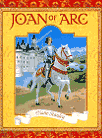 Joan of Arc Joan of Arc
Diane Stanley
Joan of Arc, born in France in 1412, grew up during a time of invasion and
civil war. At thirteen, she began to hear the voices of saints. At seventeen, she rode
into battle. And by nineteen, (1431) she was burned at the stake as a heretic. Almost five
hundred years later, she was declared a saint. In the latest of her acclaimed series of
picture-book biographies, Diane Stanley tells Joan’s story with a lively, carefully
researched text and sumptuous, gilded illustrations inspired by the illuminated
manuscripts of that time. In this glittering portrait of the illiterate peasant girl who
became the savior of France, an award-winning author once again reveals to young readers
the richness and excitement of history.
This online catalog is made possible through an association with Amazon.com.
Clicking on the book cover will take you to Amazon’s information page about that
book. You can look at its price, availability, any discounts currently taken for that
title, reviews of the book, and other information, as well as order it if you decide to
purchase the book. You can even place books in your shopping cart and save them for
purchase at a later time. You can continue to add or delete books from your shopping cart
until you are satisfied with your order and ready to purchase. Clicking on your
browser’s “Back” button will bring you back to this catalog.
Locating Out of Print Books
Sometimes books go out of print, or the publisher runs out of stock. Any book not
available from Amazon.com for any reason can be searched using AddAll.com, a book shopping site which will scan Amazon
as well as Barnes and Noble, Powell’s Books, Book Close Outs and many other new and
used book sites. Be sure to also check BookFinder.com
for out of print book searches.
If all else fails, and you cannot find a book you need, check it out from
the library, or request it from your library through interlibrary loan. Once you have the
book home, take it to a copy store and copy it. You can even have color copies done of key
maps or photographs. Copy stores can now do nice bindings on your copy projects. The copyright law allows copying of out of print
(not in print) works to be used for educational purposes. Then return the book to the
library, and you have your own book to keep, usually for less than it would be from a
collector’s book shop.
Still have questions? Ask
me!
 
|
